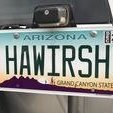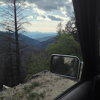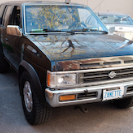Leaderboard
Popular Content
Showing content with the highest reputation since 05/08/2024 in Posts
-
General topic, maybe off-topic, but still PF love! I've been hoarding LE wheels (9 of them so far) for a while and finally got around to slapping a set of them on my 98 Frontier. Had a shop in town strip them down, repair all scrapes and curb rashes, then powder coat them in "wet charcoal with satin finish". The results came out great so I thought I'd share the journey. Started out with 17x7 4Runner wheels shown below. Tires were old (Fall 2016, installed early 2017) with only 4,100 miles and tons of tread left, but showing their age. I started a new job at the beginning of April which has me commuting again, so it was time to change them. TownDawg helped me visualize (a la Photoshop) what the LEs would look like on it... And with a little bit more drop (only 1" in the pic above)... Truck's been undergoing a slow restoration for a while (body, paint, and glass done 2022, new tint and interior around the corner) so the plan was to get a set repaired and put new tires on them. All the ones I had have varying issues, but fortunately no major ones. As much as I like the factory silver on the T4Rs and the LEs (both similar color as the original wheels), the color has always been out of place in my opinion. And for what it was going to cost to refinish each wheel (5 of them), it was actually more expensive to go with a factory finish than a powder coat ($275/ea vs $225/ea). So, bought 5 new tires and took my 5 crustiest wheels to the shop to scope color options. Was looking specifically for something that keyed off of the inset of the grille. Found a pretty good match... The results... I also stripped down a set of center caps so they could be paint matched...not too bad! Cut new adhesive for the emblems as best as I could... Installed... Just the right amount of stick-out, no spacers... Kinda gray, kinda charcoal, kinda black...depends on the light I suppose. But they came out great! New lugs and lock nuts seal the deal. LEs are 17x8 and the 235/55R17 tire is supposed to be about 27.2" diameter, but according to GPS speed it's much closer to a 26" (stock size). 27.4" tires should have offset the H233B w/ 3.9 gears (stock 3.7) according to my calculator, but I still needed to use the 18-tooth speedo pinion gear (stock 17) I had previously installed. Speedo's spot on now.3 points
-
just thought I would let you know I ended up finding Transfer Case Module with the same part number as mine for $189 a lot better then paying $2000 from Nissan,thanks are bunch for your help Slartibartfast hopefully it's just plug and play and no reprogramming needed.2 points
-
I have never found a timing belt time interval from Nissan, but it looks like other manufacturers spec less than ten years (some as low as five). Probably best to swap that belt out before it realizes that 2004 was 20 years ago.1 point
-
I may be a lucky sumbitch. The garage where I had it towed called later and said the bolt holding the harmonic balancer had backed off due to an incorrect washer being used previously. They are replacing the woodruff key and hardware and I'm having them do the timing belt water pump and front seals as well. Good opportunity to inspect the timing gear key. I lucked out that the garage is independent and has a 13 year Nissan master tech on staff who geeks out over our old trucks haha. Thanks, I sent this to the mechanic. I'm sure they'll be tired of me bugging them by the time it's all over haha. I'm not capable of the engine swap myself and having a shop do it would probably break my bank account, luckily it sounds like I won't have to make that tough decision yet!1 point
-
Some of the aftermarket u joint kits come with snap rings of different sizes/thickness. Otherwise I have filed them down to fit, not saying it's the right thing but it worked..1 point
-
1 point
-
The MAF is a good thought, and an easy one to check if you've got a half-decent scanner. Could explain the hard starting, too. That said, I wouldn't expect it to only cause problems on one cylinder. The service manual offers a little troubleshooting for misfire codes. Might be worth a read. Looks like you've tried most of what they suggest, though. I would follow the compression test with a leakdown test. When the head gasket let go on my neighbor's Toyota, the compression still tested fine, but when I applied shop air to #4, it bubbled out of the radiator. (I didn't have a leakdown tester at the time, so I stripped the compression tester down to just the hose, and stuck the air nozzle in the end.) It's probably not the head gasket--I don't remember anyone else on here having a head gasket let go on a VQ, and I imagine you would've mentioned if it was losing coolant--but it's still worth ruling out. When you replaced the plugs, did #1 stand out from the others? Color, deposits? Might give a clue if it's a mixture issue. When you installed the injectors, did they all go back in the same holes they came from? And did you flow-test them after cleaning them? If #1 has its original injector, untested, I would not rule it completely out yet. Are you sure what you're seeing in the exhaust is fuel? My dad's '03 burned an alarming amount of oil, especially on warm starts, though I don't remember it throwing misfire codes. Have you checked your your power valve screws? Long shot, but if one of the butterfly plates fell in, I can imagine it getting stuck in front of an intake valve or something.1 point
-
A friend and I did that on his Blazer. Got a bucket with measurements on it and poured in the same amount that came out each time. It would've worked better if we'd kept better track of the level in the bucket between rounds, but we got there in the end, and we didn't overfill it like I did mine. I did a bunch of work to the truck right after I got it, including the trans fluid, so I never really got a baseline for how it shifted before. After the flush, it shifts pretty well, apart from a lazy 1>2 shift under load. It hasn't gotten worse over the last 26k miles, and the transmission is still alive at 257k miles, so I'm not complaining. While you're in there, consider adding an external cooler, especially if you wheel or tow (the hotter the fluid, the faster it degrades). I also plumbed in a Magnefine external filter while I was in there. I don't know that it's doing much, but there was a little metallic shimmer in the old fluid, so I figured adding an actual filter was a good idea.1 point
-
And here's what they look like with a bed resting on them when the in-tank fuel temp sensor is throwing codes and emission tests are due soon...1 point
-
I posted a teaser pic about this on the 'What did you do...' thread the other day, but time to shed more light on the project. Long story short, I'm making a winch bumper for myself, but that idea has evolved into making a builder kit for others to build their own custom bumper around. This is the progress... I'm still iterating through some small tweaks, but here are the general features: Uses an off-the-shelf winch channel, such as the Badlands (Harbor Freight) or GoPlus (Amazon)—inexpensive, universal, and the 36" width is perfect. Weld-together kit, but entirely bolt-on to truck; no cutting, no drilling. (Well...maybe a little trimming on the windshield washer bottle's plastic lower mount, but that's it so far.) 3/4" shackle mount (eyelet is 1-1/8" thick, or 3 layers of 3/8") Retains factory tow hooks Attachment plates for building any bumper style By itself, a winch mount Uses 3/8" steel for the bracket, and 3/16" for all attachment pieces. Uses all existing tow hook and bumper attachment points, plus three existing unthreaded chassis holes (blue piece in sketch is a nut-strip that inserts into the chassis); 18 total chassis attachment points using M10 and 1/2" hardware. 8" of vertical winch clearance. A side plate (red piece in sketch) provides mounting surfaces for the control box. Slotted channel on the main bracket that allows for attaching things. Currently, working on a bracket that allows the 00-04 OE fog lights to be attached. The bumper attachment plates (green and purple pieces) are what the rest of the bumper is built around. This allows the bumper to be completely removable. The upper plate's shape allows for using up to 1/4" plate on the top and front edges. Of course, the plate can be cut, notched, or bored to use tubing, but is basically intended to be a blank canvas. The lower plates (one inside, one outside the bracket) allow for additional mounting points. The inner plates, in particular, can be used to build a receiver tube attachment, or mounting a skid plate (00-04 models have a power steering return line that is exposed). I may incorporate use of carriage bolts (think single-tool tightening) and make it so the bumper can be rotated up for easy installation, or rotated down for service, winch access, even a step for engine bay access, by pivoting on the lowest attachment bolt. I'm also designing new skid plates, and once that's done, I will be getting everything plasma cut. Hoping to do all that very soon. I guess the real question at this point is if anyone would be interested in something like this? We obviously have very little aftermarket options between ARB (is this still even available?) and TAG (I can't stand the mounting setup). There's been a bit more chat about using XJ bumpers lately, but I'm not convinced that's a better option. While this isn't a complete bumper, I think this tackles the toughest problems about starting one. Down the line, I might make some weld-it-yourself kits that use this as the backbone. Even if you can't weld, this would grossly simplify the process for a local shop that could make you one. Questions and feedback welcome!1 point





